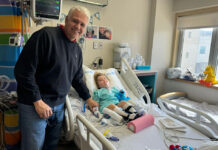
Annual screening and a healthy lifestyle are the best prevention.
By Juan Pablo Frias, M.D., Medical Director and Principal Investigator, National Research Institute, Los Angeles, CA.
People with diabetes should be talking to their doctors about liver health. Unfortunately, few people living with diabetes focus on the connection between liver disease and type 2 diabetes — but they should. In fact, between 50 to 70 per cent of those with type 2 will develop fatty liver disease.
The most common liver disease, asymptomatic non-alcoholic fatty liver disease (NAFLD), is inextricably linked with type 2 diabetes. Because of the liver’s central role in so many body processes, excessive fat in the liver can have a ripple effect. It is associated with an increased risk of developing cardiovascular disease and can make type 2 diabetes more difficult to treat.
NAFLD is characterized by a build-up of fat in the liver that’s unrelated to excessive alcohol intake. Some persons have excessive liver fat buildup without significant liver damage, so-called non-alcoholic fatty liver [NAFL] or “isolated steatosis.” In others, the liver fat causes inflammation and liver cell damage. This condition is more serious and is termed non-alcoholic steatohepatitis (NASH). It is estimated that about 20 per cent of patients with NAFL will progress to NASH. Without treatment, in some patients, NASH can progress to cirrhosis (chronic scarring and damage), liver failure, and possibly liver cancer.
NAFLD is a complicated condition, and is associated with:
• Overweight or obese
• Insulin resistance (a condition in which the body doesn’t use its own insulin properly)
• High blood sugar levels (prediabetes or type 2 diabetes)
• High levels of fat, called triglycerides, in the blood
• Sleep apnea
• Polycystic ovary syndrome
Typically, NAFLD carries no symptoms unless in an advanced stage. Sometimes abnormal liver tests appear during a routine blood test and your doctor might suggest further testing. Healthcare providers might also order an ultrasound, CT scan, or MRI to see if your liver is abnormal, but none of these tests alone are the standard for diagnosing NAFLD.
NAFLD is typically diagnosed based upon evidence of increased liver fat with an imaging procedure such as an ultrasound and the elimination of other disorders that may lead to fatty liver. In some cases, a liver biopsy is ordered to look for the extent of inflammation, liver damage, or scarring. Nevertheless, early detection is critical becauseif caught in the early stages and treated with by lifestyle changes leading to weight loss, liver fat can be reduced and NAFLD may be reversed.
Screening and early detection of NAFLD can help to create actions that may prevent more serious conditions such as end-stage liver disease or liver cancer. Fortunately, there’s been growing adoption of new non-invasive screening methods that can detect NAFLD in the absence of indications or warning signs.
Non-Invasive Screening Now Available
This new painless approach can be performed in the doctor’s office as part of an annual exam, and is often covered by Medicare, Medicaid and other insurance plans.
FibroScan®, for example, is a 10-minute painless tool that measures your liver fat and liver stiffness (associated with fibrosis and cirrhosis). FibroScan emits a pulse of energy, which you may feel as a slight vibration on your skin. FibroScan then measures the speed of this energy and immediately provides this information to your physician, who then uses it as part of a broader evaluation of your liver health.
When included as part of your overall health assessment, FibroScan can provide your healthcare provider valuable information on your liver health, and for many patients, remove the need for a painful liver biopsy or further testing. Test scores also provide information the physician needs to track your liver health over time, and to make a referral to a specialist or recommend additional assessments in the event that your liver health changes. In fact, a yearly NAFLD screening may eventually become standard practice similar to a mammography or A1C blood sugar testing.
Lifestyle Change and Medication Checklist
According to The Diagnosis and Management of NAFLD: Practice Guidance from the AASLD, the following lifestyle changes can help reduce the amount of fat in a patient’s liver:
Weight loss: Overall weight loss is the key to improving NAFLD and NASH. Losing between 5 – 10 percent of weight helps to improve fat buildup, liver cell injury, and inflammation. Patients should consult their healthcare provider or dietician for recommendations about an appropriate diet.
Exercise: Exercise helps to indirectly prevent and help treat NAFLD by helping with weight reduction, improving insulin sensitivity, improving blood sugar control, and lowering the risk for heart disease.
Medicines: Although there are currently no medications approved by FDA for NAFLD, a certain type of diabetes pill — thiazolidinediones (TZDs) — boosts insulin sensitivity and has been shown to reduce liver fat and inflammation.
Diet: The Mediterranean diet is higher in monounsaturated fatty acids. This is helpful for both diabetes management and reducing the risk of heart disease. Limiting the intake of refined carbohydrate foods, such as sugary foods and high-fructose corn syrup, and replacing some carb intake with monounsaturated fat (found in olive oil and nuts) can also be elpful. Compliance with a calorie-restricted diet is associated with mobilization of liver fat. The overall sustainability of weight loss is most important, rather than the specific composition of the diet.
Limit alcohol consumption: NAFLD isn’t caused by drinking alcohol, but alcohol can make the condition worse, and people should seek advice from their doctor on how to avoid it altogether.
Understand your liver health
With advances in painless tools to assess and monitor your liver, it is now possible to track liver health as part of your overall health assessment. This may be especially important for people living with type 2 diabetes, where excess liver fat has been associated with increased complications and mortality. Learn more about your liver, how it may be affecting your overall health, and how a healthy lifestyle can improve your liver health.
Located in Los Angeles, Huntington Park and Panorama City, CA, National Research Institute has provided free quality medical care to patients with diabetes and performed clinical studies for patients with diabetes, obesity, fatty liver disease and other medical conditions for over 30 years. https://nritrials.com/











